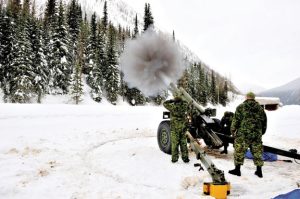Operation Palaci booming success
By Lookout on Feb 27, 2016 with Comments 0

A Roto 2 member takes a sight of the avalanche zones on Rogers Pass on one of the 105-mm C3 howitzers located at a road-side gun platform.
Ashley Black, CJOC ~
For over 50 years, the Canadian Armed Forces (CAF) and Parks Canada have been preventing avalanches using the best known method: creating avalanches.
In 1962, Roger’s Pass opened as a mountain pass where the Trans-Canada Highway and the Canadian Pacific Railway cross the Selkirk Mountains in British Columbia. In an effort to prevent naturally-occurring avalanches, Parks Canada and the CAF partnered together for Canada’s largest avalanche-control program, known to the CAF as Operation Palaci.
The annual program starts in late November with the goal of preventing uncontrolled avalanches by creating small, more frequent avalanches in controlled settings.
For this year’s first rotation, 17 members of the Avalanche Control Troop have deployed to Operation Palaci and have been through extensive training to prepare for avalanche control operations.
To ensure the program is successful, Parks Canada staff is responsible for examining snow profiles. Their experts examine snow temperatures, moisture content and conduct various stability tests to determine when avalanche control may be required.
Parks Canada’s avalanche forecasters, and technicians, closely monitor weather, snowfall and snow pack to assess avalanche hazards.
“This analysis is an ongoing, iterative process,” said Jeff Goodrich, Senior Avalanche Officer at Parks Canada.
If a snowpack is deemed unstable after much analysis, Parks Canada calls upon the CAF to perform avalanche control operations. A C3 105-mm Howitzer is used to conduct shoots that create small, controlled avalanches.
“Pre-registered targets are carefully chosen by Parks Canada in order to trigger avalanches before they become a danger to the highway. Upon order, the Avalanche Control Troop engages these targets with high explosive projectiles fired from the C3 105-mm Howitzer from various gun positions along the highway,” said Lieutenant (Lt) Aaron Brideau, troop commander for Operation Palaci’s Roto 1.
The CAF’s high readiness and training prepares the troop for when it is essential to conduct avalanche control operations. This level of readiness ensures the CAF can perform its operational duties as efficiently as possible to avoid prolonged highway closure times.
For Lt Brideau, witnessing the controlled avalanches reaffirms the purpose of the program.
“The most surprising thing when witnessing an avalanche for the first time is the sheer size of the snow cloud as it comes down the mountain. It underscores the requirement for avalanche control operations in Rogers Pass in order to ensure the safety of all who are travelling through,” he said.
The Avalanche Control Program permits motorists to safely use the Trans-Canada Highway and the Canadian-Pacific Railway throughout the winter. It also allows for Parks Canada to ensure the safety of their visitors and staff at Glacier National Park.
“Op Palaci is an excellent example of how government organizations can work together using their individual expertise to achieve a common goal,” said Jeff Goodrich.
The annual success of the world’s largest mobile avalanche-control program using artillery fire can be attributed to the strong partnership between the CAF and Parks Canada.
“At the troop level, the relationship between us and Parks Canada is outstanding. They are incredibly professional and skilled at what they do,” said Lt Brideau.
Operation Palaci continues until April 2016.
Filed Under: Top Stories
About the Author:





